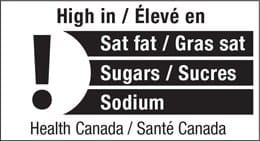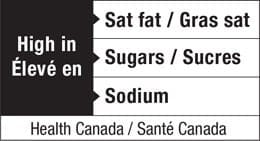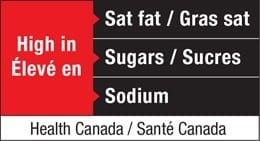Back in October 2016, Health Canada outlined 6 actions in its strategy to create a “better food environment enabling Canadians to make healthier eating choices as part of a healthy lifestyle.”
Those 6 actions were as follows:
- Update Canada’s Food Guide: The 6-page Canada’s Food Guide was revised into targeted products to communicate relevant, consistent and credible dietary guidance.
- Better Labelling: (1) New regulations for the Nutrition Facts table and List of Ingredients on food labels and (2) New front-of-packaging (FOP) labelling for products high in sugar, sodium and saturated fats.
- Reducing Sodium: Establish sodium reduction targets for the restaurants and foodservice sector.
- Eliminate Trans Fat: Eliminate industrially-produced trans-fat from the food supply.
- Restrict Marketing to Kids: Implement restrictions to the commercial marketing of unhealthy foods and beverages to kids.
- Nutrition North Canada (NNC): A program that will provide a retail subsidy to make nutritious foods more accessible and affordable to isolated northern communities, along with education and awareness activities.
With healthcare costs in Canada reaching an estimated $242 billion last year, the federal government is looking to curb the alarming rise of chronic and preventable diseases such as obesity – the causal factor in a number of chronic illnesses including heart disease, diabetes, high blood pressure, arthritis and even some cancers.
Many of these illnesses can be managed by making lifestyle changes and adopting healthier eating habits.
Is it any wonder the federal government wants to help Canadians shape up and trim down?
What Does This Initiative Mean For Today’s Food Processors?
They not only have to deal with these legislative issues, but also face industry challenges, changing consumer habits, supply issues, operational and food safety concerns, even competitive threats and activities.
As much as food processors love to feed Canadians, they also must be profitable businesses and ensure their own long-term viability.
For food processors, the actions that will directly affect their business are numbers 1-4 (listed above). As of April 2018, consultation on proposed nutrition labelling changes is now closed, with Health Canada intending to announce the final regulations in December 2018. This will allow manufacturers a 4-year implementation period to update their labels (December 2022).
The following post is a guide from a strategic marketing perspective on the proposed changes brought by the Healthy Eating Strategy and my recommendations on how food processors can tackle them head-on.
Changes to Canada’s Food Guide Will Result In A Long-Term Change in Consumer Behaviour
One of the fundamental changes proposed will be an update to Canada’s Food Guide.
Remember: The biggest threat to any industry is a sustained change in demand. In food, this takes the form of changing consumer behaviour, usage, or beliefs about certain products or categories.
For example, a recent positive change has been the appetite for avocados (thank you hipster toast trend) for their potassium and monounsaturated fatty acids, or the rapid rise in blueberry consumption for their antioxidant properties.
Over time, these changes will affect consumer consumption which means food processors will need to rethink product portfolios, capital equipment expenditures and long-term sales forecasts.
Nutrition and Ingredients Changes
There are three major changes coming to food packaging regarding the education and declaration of nutrients and ingredients:
1. The Nutrition Fact Panel
Nearly one third of Canadians don’t check food labels when deciding which foods to buy and eat. In 2016, several changes were introduced to the Nutrition Fact Panel to help consumers understand what they were consuming compared to the recommended percentage of Daily Value.
The bulk of those changes were designed to help consumers easily compare foods to make the “best or healthiest” decision. Health Canada is hoping to align serving sizes of comparable products to help consumers understand how the nutrition compares.
To give you some context, consider this: We work a lot in the bread industry and know that the serving size can vary between one or two slices. That can mean a big difference when brands like Dave’s Killer Bread have products with six grams of sugar per slice vs. Silver Hills Bakery bread that only contains one to three grams.
Single serve foods are now required to have nutrition facts for the entire container (up to 500 ml) because – let’s be honest – we just know someone, somewhere is going to consume all of it in a single sitting.
2. The Ingredient Listing
Ingredients are the real answer to the question “What am I actually eating?” There’s been a greater trend to reducing and cleaning up ingredient lists to help consumers understand what they’re eating, and to position products as a healthier option by having as few ingredients as possible.
The new changes are designed to group ingredient classes together and the main target is sugars. As seen in the image, grouping fancy molasses with the other sugars helps consumers understand the sources of the sugar within the Nutrition Facts Panel. The big elephant in the room is whether consumers know the differences between sugars – which they most often don’t. As an example, there’s a big difference between coconut palm sugar and fructose.
Other changes include listing food colours (by their specific common names), making the text a black font on a white or neutral background, creating minimum type height requirements for ingredients and using bullets or commas to separate ingredients.
3. The Front-of-Package Nutrition Labelling
The final proposed packaging change – and probably the most controversial – is the front-of-package nutrition symbol. The four proposed variations shown below. The symbol’s objective is to help consumers quickly identify foods that are high in sodium, saturated fat and sugars.
Once the labelling standards have been published, food processors will have until 2022 to comply. This should hopefully be enough lead time to allow product reformulations, and to adjust food packaging.
The image options shown here were proposed to consumers for feedback. My bet is the “magnifying glass” with a black and white colour pallet will win. It’s a softer statement that reinforces the need for consumers to look and be aware. The “exclamation mark” is bold and clear but can leave the impression that the food is not safe to eat or should be eaten with caution. The red will likely not work, as it introduces another colour that will increase packaging costs and clash with current designs.
In light of these upcoming changes, what strategies can Food Processors take?
1. Lobby Against It
The Canadian Dairy Industry is pursuing this, arguing that the new labelling requirements ignore the level of essential nutrients their products contain. Their concern is a potential drop in demand if consumers avoid foods with nutritional warning labels – dramatically impacting their domestic market.
With fluid milk consumption already on a gradual decline, the industry can’t afford to see processed products do the same. Fluid milk will not require these new labels, but other processed products such as some cheese, butter and yogurt fall into the “high in sodium, sugar or saturated fat” category. For example, some flavoured yogurts can contain up to 31 percent of the recommended daily value intake in sugar consumption. (But peach yogurt tastes so good, doesn’t it?)
Lobbying should be undertaken by the industry or member associations to avoid brands being perceived as negatively impacting the health of Canadians. And keep in mind that while lobbying the federal government in the food industry may delay or slow the progress of an initiative, it rarely stops it altogether. Sometimes, concessions are made but there must be some very convincing arguments for that to happen.
2. Alter Product Formulations
This is probably the best route to take for processors who have products and brands that exceed the requirements. The big challenge here is to determine if they can maintain the taste profiles that consumers have come to love while reducing the sodium, sugar or saturated fat levels. This issue will be front and center for R&D teams.
Don’t forget that the new labelling changes are designed to help consumers compare similar products. This means that formulations will need to match or beat competitors’ in easily identifiable health markers such as calories, protein, fibre, sugars and fat – all while tasting great. No problem, right?
To help offset this, I predict the rise of unique ingredients that will augment taste while also aiding nutritional benefits. One such new ingredient is GOS (Galacto-oligosaccharides), a sweet-tasting dietary fibre developed by Vitalus Nutrition. GOS could provide a sweet note to products while improving the fibre claim on labels.
3. Educate Consumers
An American study suggested that 1 in 3 consumers say they rarely look at nutrition labels, and over half of that group (53 percent) indicated that they “wouldn’t know what to look for anyway” as a reason for why they didn’t read them.
This presents a huge opportunity for food processors. Though I typically advise clients to allow the industry or market leaders to educate consumers (it can be very expensive with diminishing returns) – if they have a competitive advantage with their nutrition, by educating consumers they can encourage switching behaviour. The education would need to be entertaining and easy to understand, but may be well worth it if they position their brands correctly.
4. Diversify Portfolios
The main decision that most food processors will need to make is how to structure their product portfolio over the long-term. “Better for You” products have been around for a while, yet for some companies this category still only represent a small amount of a total product portfolio.
Consumers often say they want to eat healthier but don’t always make that decision with their wallets, which is the real indicator. It’s also why some organizations have been quick to dismiss this trend as not having any real effect. Remember that we’re still in the early stages of Canada’s Healthy Eating Strategy (changing consumer trends – health conscious) and timing will be everything.
My advice is not to pivot dramatically just yet. Consumer behaviour and changes take time, especially when the evidence is seen as vague or difficult to understand. I would recommend:
- Expanding core brands to encompass healthier options
- Prepare to build new brands that fit into healthier categories, that can utilize existing equipment and capabilities
- Another alternative is to acquire smaller, health-focused brands that could positively position themselves in the market while the rise in demand takes shape.
In a portfolio, it’s a good idea to have different products that meet different needs at different times so they can capture as much of the market as possible, while delivering on a company’s mission and vision.
Truth Always Wins
In marketing – as in life – the truth always wins. North Americans have grown accustomed to a diet rich in sugars, sodium, and saturated fats. Those foods appeal to the human palate for three reasons: taste, convenience, and price. The problem is that these kinds of foods do not contribute to optimal performance of the human body and contain a higher number of calories that, when combined with lower activity levels, leads to weight issues and chronic health problems.
Much of the health evidence that preceded these changes is already out there. But because consumers have been reluctant to embrace that evidence – and make corresponding diet and lifestyle changes – the federal government feels the need to step in.
The facts and the data may be scrutinized – even buried for a time – but eventually they will emerge.
Consumers may not like the changes because they’re less convenient and they don’t taste as good as their usual fare. Industries and organizations may not want it because they’ve invested millions in equipment and infrastructure, and a change in demand will undoubtedly cause huge losses.
But in the end, I believe the truth always wins so the best approach to these changes is to face them, embrace them and then make a plan that will help you stay ahead of them.





